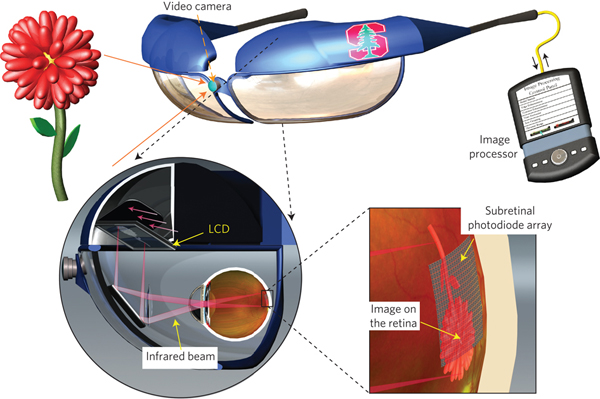Retinas are complex systems and engineered rescues of vision loss through bionic means have to date been inelegant solutions. Retinal bionic implants have historically not been successes due to some glaring problems including how to power them and how to get the appropriate current close enough to the cells to induce a response. However, researchers at Stanford University and University of California, Santa Cruz have now developed a photovoltaic retinal prosthesis that is wirelessly powered which eliminates one of the biggest hurdles on the viability of bionic implants as well as pioneering flexible arrays which gets around high current issues which resulted in unacceptable heating of the implant (read: cooking the retina).
Photovoltaic designs have been championed before by groups that did not completely understand either the biology behind retinal degenerative disease or the engineering behind what is required to adequately transduce signals to the remaining retinal neurons. Previous “light powered” designs by other groups had very low efficiencies. If one did the calculations, it was equivalent to shining the sun directly into the eye to provide enough current to power the device, a completely impractical solution. Also, because of the large distances involved between the implant and the retinal neurons that it was supposed to be powering, currents were unacceptably large.
The group including Keith Mathieson, James Loudin, Georges Goetz, Philip Huie, Lele Wang, Theodore I. Kamins, Ludwig Galambos, Richard Smith, James S. Harris, Alexander Sher & Daniel Palanker developed glasses outfitted with a video camera that then projects the image in near infrared light onto the bionic implant. The use of infrared light allows much higher power to be used without compromising existing retinal function in peripheral regions as well as being able to adequately power the device as each pixel has its own power supply in the photodiode. It also dramatically simplifies the surgery required to implant the device which will be important given the scarring from Müller cells in the retinas of patients with retinal degenerative disease.
Three of the authors Daniel, Sasha and Phil have talked with me about these issues extensively in the past and I had a preview of some of the technology during some of my visits to Stanford. So I eagerly look forward to future testing with these devices to see how they work in models and potentially, eventually the clinic. There are a number of biological issues still to resolve with these devices, but this is the right engineering step forward if bionic retinal implants are going to work to recover vision loss.
